So many aspects of SEO rely on content these days.
If you want organic visits, content is going to be your number one traffic driver. While local SEO relies on its own set of tactics and strategies, it’s also grounded in high-quality, relevant content.
“But,” you say, “isn’t local SEO all about getting reviews and optimizing your Google Business listing? And getting citations (local listings) in as many places as possible on the web?” Well, yes! We’re not here to tell you that’s wrong because that’s definitely true. There’s just more to it than that.
Do all those things, and do them first. When you’ve done all of that, and it’s time to dive deeper into your local SEO strategy, put on your content strategy hat, and dive into our guide.

How to develop a content strategy for local SEO
This guide will go over the tactics you use when working on local SEO and look at them with content in mind. How can each tactic be improved with a focus on content strategy? Here’s a look at how to develop a content strategy for local SEO.
Google Business Profile
If you’ve ever read an article on local SEO, a Google Business Profile is probably the first thing you read about. You MUST not only set up your listing, but make sure you’ve got as much information there as possible and keep it updated constantly.
Seriously, fill in everything you can. Add photos. Get reviews. The whole shebang.
After you’ve got that bit locked in, you can start thinking about how content strategy can help you here. Thanks to Google Business posts, you can use content to not only help keep your listing updated but also to provide added value to your profile viewers with a link to a highly relevant piece of content on your website.
Not only does that give you another spot to reach customers, but it also gives them another chance to interact with you and click on your website. Yep, posts can help drive traffic to your website. You just have to provide the right content there!
Posts can be used to inform or drive traffic, or both. Here are a few ideas for what kinds of content you can create to share in your Posts, depending on your business type:
- A listing of weekly specials or sale prices
- A super relevant how-to
- Company news/announcements/events
- Popular product or service highlights
Here’s a great example of a local HVAC company providing a special within their Google Business posts:
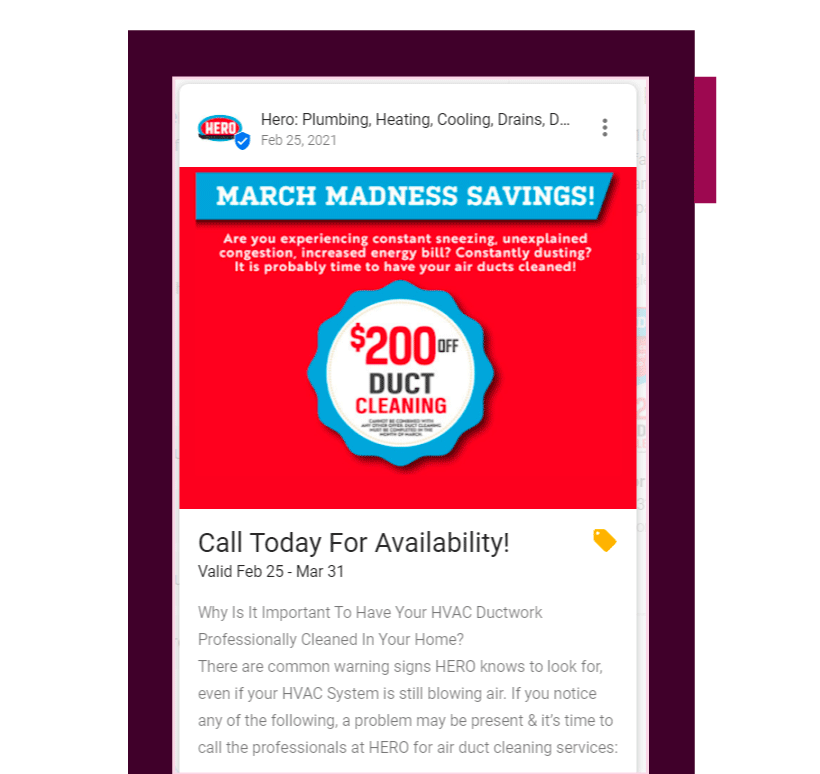
Their offer is timely, eye-catching, and yes, we’re all sneezing here, so why not? At the bottom of the offer, there’s a link to find the offer on their website:
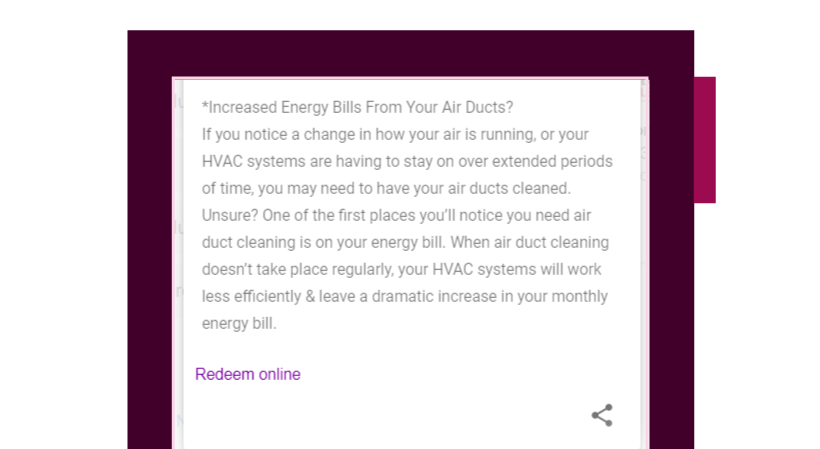
All of the content within the post is compelling and is making us believe we need our air ducts cleaned. What’s even smarter of them is their previous post, which is still mostly visible in the posts carousel, and is a picture of a pretty gross duct:
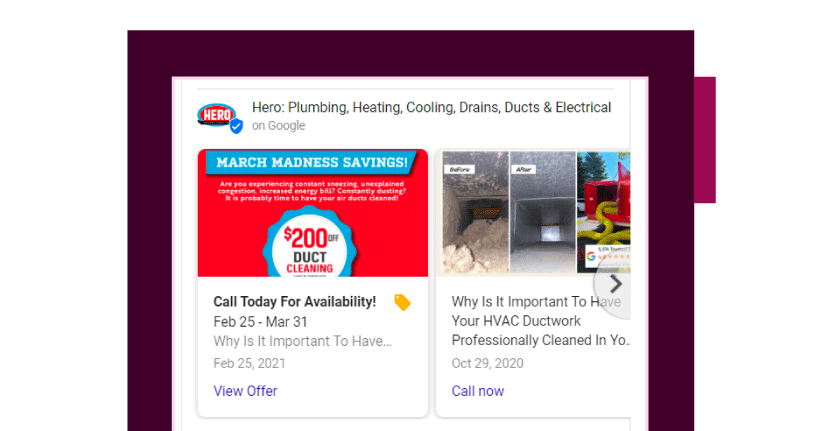
Overall, a nicely thought-out post. The only thing we’d change about it is their “Call Today For Availability!” headline. You have to search the picture to find out that it’s for a duct cleaning, so that should have been in the headline.
Google also provides a template for when you’re just looking to highlight a product and link to the product page on your website, as well as templates to share an offer or event. Play around with these types and use the “what’s new” type to create your own. Try them out. Experiment. Find out what type of content drives traffic and conversions for your business.
Reviews
Along with your Google Business profile, reviews are a HUGE part of a content strategy for local SEO. You always want to be working on getting more and increasing your rating.
Can a content strategy help you get more good reviews? Absolutely!
There are two content strategy ideas we’re thinking about here that can help you get more positive reviews (along with other more measurable review generation techniques, like asking for them, of course).
Answer frequently asked questions with content
Have you ever been incredibly frustrated by a poor review that resulted from a misunderstanding or miscommunication? They happen pretty often for companies and brands across the whole gamut of industries and niches.
While some of these aren’t going to be helped by extra content (letting a prospective client fall through the cracks and forgetting to respond, for instance), some of them can be.
For example, let’s say you’re an internet marketing agency (with mostly local clients) that offers SEO as a service. A new client is expecting to see results instantly, not understanding that it can take a little time to see results from a just-launched SEO campaign.
Maybe you went over it in a meeting with the client when they were signing on, but it didn’t quite land in their brain with all the other stuff going on. So, the client heads to Google and gives you a one-star review after their first month’s analytics don’t show any improvement.
How could this have been avoided? Planning your content strategy for local SEO. Perhaps an article titled “How long does it take to see results from SEO?” could have been sent out in an email. Maybe you have a whole set of “Vital Facts to Know When Starting an SEO Campaign” content that goes out to freshly signed clients.
Publish reviews on your website and other channels
Publish reviews… to get more reviews? Sure! If you take time to highlight the great reviews you’re getting, that can remind someone who also had a great experience to leave you a review.
Where to publish and promote your great reviews:
- Your website
- Social channels
- Landing pages
- Case studies
- Videos
Include a link to leave a review when you share them if it makes sense on that channel.
On-page content for local organic results
While the first two tactics focus mostly on getting into the map pack on the search results page, on-page content can help you rank below it in those important organic spots. To snag those, you must have a content strategy for local SEO in place!
First of all, you need to do some local keyword research and decide where you’d like to focus your efforts. While the map pack can rank you for the area you’re located in, you can rank in nearby areas in the organic results if you employ the right content strategy.
For instance, let’s say you’re an HVAC company located in Pineville, NC., an immediate suburb south of Charlotte. While you can rank in the map pack for nearby searches, you probably won’t be seen there when someone searches from, say, Matthews or Mint Hill, which are suburbs southeast of the city.
It’s close enough for you to want business there but not close enough for someone searching there to find you in the map pack (at least, not in the top results visible on the first page).
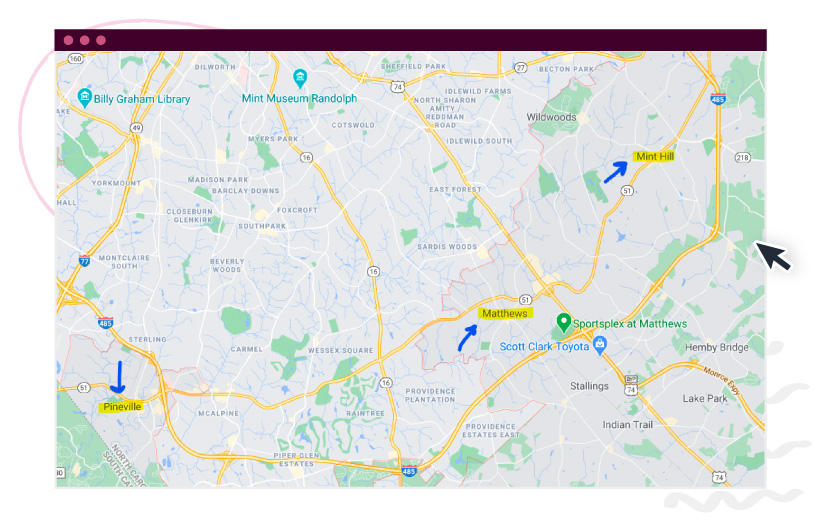
With content, you can target keywords like “Mint Hill HVAC company” to rank in the organic results just underneath the map pack in the Mint Hill area.
Here are a few ideas for how you can use on-page content in your local SEO campaigns:
- Create landing pages for your targeted cities or neighborhoods
- Create blog posts focused on those targeted areas, such as success stories, project features, case studies, or whatever makes sense for your business
- Create informative, sharable content that links back to your targeted area pages
Link building
Link building will be an essential component of your content strategy for local SEO. Local businesses need to build links, just like any other website does. You’ve probably read some articles with ideas for getting local backlinks to your website, such as belonging to the Chamber of Commerce, sponsoring an event or local team, and getting mentioned in local media.
These are great suggestions, and you should definitely try them! However, let’s take a look at how you can use content here rather than just looking for a link to your home page.
Think: What can you write about that other local places or blogs might find useful and want to share/link to?
An article featuring local suggestions is a great place to start. Everyone’s looking for the “best” such-and-such in a city, town, or neighborhood. Somebody who’s traveling to or is new to an area often searches for things like “best hotels,” “best restaurants,” or “best bars” along with a local keyword.
Write a “best of” article about your area to attract that traffic, plus links and shares from businesses you’ve mentioned or from other local websites.
You could also list or feature some local events, especially if you’re playing a role in them. For instance, let’s say you’re going to take part in a local Halloween celebration where businesses give out candy or other prizes.
Instead of writing a couple-paragraph article to say you’re taking part, how about a longer one that describes how to find who’s doing it, the timing, and other details? You could even make a little candy map, provide links to other Halloween resources, create a special pumpkin carving template, etc.
You can get really creative here! Try to think of industry-specific content, too.
A few examples:
- A hair salon could create content about season- and area-specific hairstyle trends
- A financial institution that provides mortgages could feature local homes for sale at various price points
- An auto repair shop could provide a list of best tires for the geographical area and season, or a listing of the best car washes
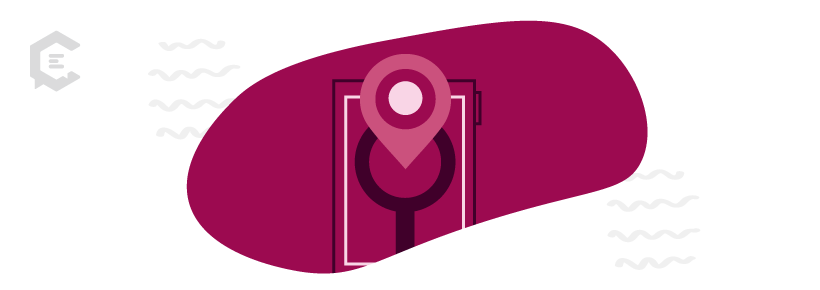
Social media & email
These channels are similar content-wise, so we’re grouping them together. Both require engaging content and are necessary channels for local businesses.
While neither of these channels directly affect your SEO, they do indirectly by sending traffic to your website and (hopefully) helping you build backlinks.
You want your followers and subscribers to engage with what you’re sharing by clicking to visit your website, commenting on your social post, and/or sharing it with their own networks.
All of the ideas and strategies we went over for making linkable content above will also work here, but let’s expand a little and talk about what’s going to get the most clicks and shares.
Coupons & offers
People love to save money, so coupons and offers tend to do well in email and social media, both for clicks and shares. This is why they should be included in your content strategy for local SEO. Experiment with having a user click through to your website in order to access andor save the offer.
Human stories
It can sometimes be difficult for businesses to come off as people rather than nameless, faceless entities. If you always think like a “we” and project that on social media, it’s hard for followers to really get to know your business.
So, start featuring really human stories. You could write about an “employee of the month” or create a feature on your president/CEO, or anything that shows there are real humans behind the façade of your business.
Videos
Using videos impacts your SEO by giving you another spot to appear in the SERPs.
Local listings
Last but not least, let’s talk briefly about using content for your local listings. NAP consistency is the buzzword here — that’s name, address, phone number. These three things must always be the exact same across all of your listings.
There aren’t a huge number of opportunities to use content when creating local citations. But that doesn’t mean there aren’t a few.
For example, let’s say you run a local restaurant and you find a local food blog that will run an interview and recipe for you. You can use this opportunity to ask for your name, address, and phone number to be included in the article.
That way, you’re not only getting a link back to your website, you’re also getting another NAP mention out of the deal. Whether you’re guest blogging or doing some affiliate marketing, any time you’re creating content that’s not being published on your own website, try to include your NAP.
Local SEO next steps
Local SEO can be tricky. But it’s super important, especially for small businesses. If you need help creating a content strategy focused on local SEO, ClearVoice has your back. Talk to one of our content specialists to see how we can maximize your business’s local SEO potential.



